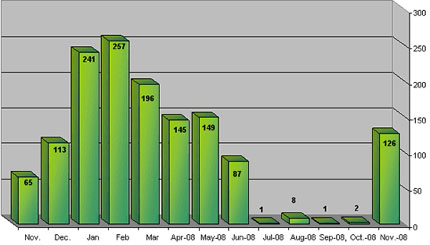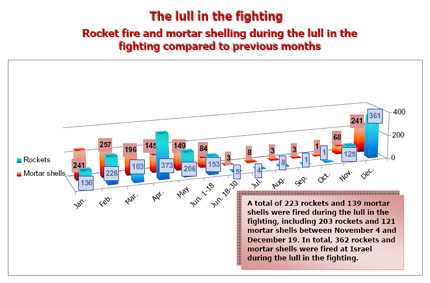The numbers never lie — unless they come from Jackson Diehl
In yesterday’s Washington Post, deputy editorial page editor Jackson Diehl presented his case on how Israel “won” the war in Gaza and how this bodes well for the Israel’s prospects in the event that it launches an attack on Iran.
Reviving neocon hubris from days of yore, Diehl poo poos the dire predictions that some have made about the consequences of an attack on Iran’s nuclear facilities, saying: “even a partial and short-term reversal of the Iranian nuclear program may look to Israelis like a reasonable benefit — and the potential blowback overblown.”
To make his case, Diehl cites the lull in rocket attacks from post-war Gaza as proof of the “success” of the war.
Israel’s satisfaction starts with a simple set of facts. Between April 2001 and the end of 2008, 4,246 rockets and 4,180 mortar shells were fired into Israel from Gaza, killing 14 Israelis, wounding more than 400 and making life in southern Israel intolerable. During what was supposed to be a cease-fire during the last half of 2008, 362 rockets and shells landed. Meanwhile, between late 2000 and the end of 2008, Israeli forces killed some 3,000 Gazans.
Since April there have been just over two dozen rocket and mortar strikes — or less than on many single days before the war. No one has been seriously injured, and life in the Israeli town of Sderot and the area around it has returned almost to normal. Israeli attacks in Gaza have almost ceased, too: Since the end of the mini-war, 29 Palestinians, two of whom were civilians, have been killed by Israeli action.
A “ceasefire” during which 362 attacks occurred doesn’t sound like much of a ceasefire — except for the fact that Diehl is grossly misrepresenting the numbers. 324 of those attacks occurred after Israel unilaterally broke the ceasefire on November 4, 2008.
As I wrote in late December, a few days after the war began:
When, after ignoring the subject for several days, the New York Times finally got around to making an editorial pronouncement on the war on Gaza, it trotted out what is among most inattentive observers the conventional wisdom:
Hamas never fully observed the cease-fire that went into effect on June 19 and Israel never really lived up to its commitment to ease its punishing embargo on Gaza.
In fact, Hamas’ compliance with the ceasefire was stunningly disciplined. Don’t take my word for it. The proof comes from the Israeli government.
Look at this graph provided by the Israeli Foreign Ministry showing rocket attacks from Gaza per month during 2008.
From January through June there were an average of 179 rocket attacks per month. From July through October there were an average of 3 rocket attacks per month.
For the residents of Sderot, those months were indeed a period of calm. But the calm ended when Israel unilaterally broke the ceasefire right after the US elections and just before Hamas and Fatah sat down for crucial reconciliation talks in Cairo.
If Israel, as it would currently have the world believe, was so strongly in favor of extending the six-month ceasefire, why did it attach so little value to what had already been accomplished? Why did it not acknowledge the effectiveness with which Hamas was holding up its side of the bargain? Why did it not demonstrate that it valued the calm by lifting or at least easing the economic embargo on Gaza in a significant way?
All Israel accomplished was to confirm Hamas’ suspicions — suspicions shared by most Palestinians — that Israel cannot be trusted.
Did it matter to the Israelis that they could be damned by their own statistics? Apparently so, for within a few days of my drawing attention to the success of the truce, the Ministry of Foreign Affairs had removed the evidence.
As I then wrote:
Now that the Israeli propaganda machine is revved up to full throttle, the image of an effective truce no longer suits the Israeli government’s purposes. Instead it has become more convenient to try and hide the numbers — with numbers! The foreign ministry has thus removed the simple graph shown above and replaced it with this:
In the earlier image, graph blocks dramatically portrayed the rise and fall in rocket fire rates. In the revised image, blocks of equal size (containing numbers) are used to obscure the graph. The effect, clearly intended, is to try and portray the lull as really nothing more than a minor undulation in a period of unremitting attacks.
The message Israel now wants to sell is that the truce never really worked. Instead of acknowledging that the truce effectively collapsed when Israel launched Operation “Double Challenge” on November 5, the rocket fire that followed that Israeli raid is being used to obscure the fact that rocket fire had effectively been curtailed up to that point.*
On the IDF Spokesman web site, a post on rocket statistics simply omits the part of the record that Israel now finds inconvenient to acknowledge:
- Between Hamas’ takeover and the start of the Tahadiya (State of Calm), (June 14, 2007 – June 16, 2008), there was an average of over 361 attacks per month—an increase of an additional 350%.
- On Nov. 4 – 5, Israel launched Operation “Double Challenge”, targeting a tunnel Hamas was building as part of a plan to kidnap Israeli soldiers.
- From the end of Operation “Double Challenge” until the end of the Tahadiya, (Nov. 4 – Dec. 19, 2008) a period of only a month and a half, there were 170 mortars, 255 Qassams, and 5 Grads fired upon Israel’s civilian population centers.
- Since the end of the Tahadiya (Dec. 19, 2009) until the beginning of Operation “Cast Lead,” (Dec. 27, 2008) a period of little more than a week, there were approximately 300 mortars and rockets fired onto Israel.
- Since the begining of Operation “Cast Lead”, there have been an additional 500 launches, 284 of which have been verified as rockets (both Qassams and Grads), and 113 as mortars.
Was four months of calm really worthless? Given that it became the precursor to war, the answer now apparently is yes.
But it didn’t have to turn out this way. The effectiveness with which Hamas enforced a truce should have provided the impetus for Israel to lift its economic siege of Gaza.
Instead, we are once again witness to Israel’s seemingly insatiable appetite for war, even while it never tires of professing its love of peace.
* Should anyone doubt that the Israeli raid (official declarations about Israel’s commitment to the truce notwithstanding) constituted a unilateral breach of the truce, consider what Israel and the world’s response would have been in the event that the raid had been launched from Gaza. Hamas gunmen conducted a raid inside Israeli territory, killing six Israeli soldiers.
That wouldn’t have been described as a breakdown in the truce; it would have been regarded as an act of war.




Yes, good analysis Paul. British Channel 4 News did a brilliant piece on this too. Watch the video at 2:05. The key moment is the interview with Mark Regev, at around 3:00, when he admits Israel broke the ceasefire, then of course proceeds to ramble on with prepared Hasbara about the “ticking tunnel.”
http://www.channel4.com/news/articles/politics/international_politics/is+israel+safer/2900687